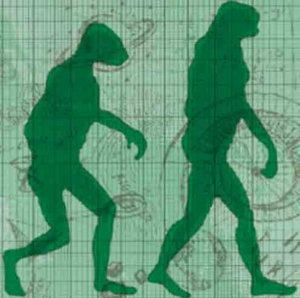This article is a preview from the Winter 2015 edition of New Humanist. You can find out more and subscribe here.
Physics – Ceri Brenner
Hold out your hand. Can you feel them? 100 billion are passing through your hand every second. “I have done a terrible thing, I have postulated a particle that cannot be detected,” said Wolfgang Pauli, the quantum physicist who first suggested it in 1930. Less than a decade later Enrico Fermi laid out the theoretical basis for this particle and named it the neutrino, Italian for “little neutral one”.
Neutrinos are the lightest particles, by far, in the family of elementary particles and have no charge, which means they don’t feel the electromagnetic force (which causes opposite charges or magnets to attract), nor the strong force (which binds particles in the nucleus). They fly almost straight through anything, leaving no trace of their flight path. And yet the Standard Model, which explains particle physics, doesn’t work without them. They come in three “flavours”: electron-neutrino, tau-neutrino and muon-neutrino, and have a mass of 1 millionth of an electron.
Every so often, they bounce off the centre of an atom. When that happens, some of their movement energy is converted into mass to produce a charged particle; the process is observed as a flash of light. In the late 1990s, two independent teams built neutrino detector systems to catch a glimpse of this strange-but-true particle. They both used huge water tanks (so that the flashes of light could be seen even in a huge volume) buried thousands of metres underground to shield from any other radiation signal. One team was looking for muon-neutrinos generated from cosmic radiation and the other for electron-neutrinos from the Sun. Their experiments gave results that demonstrated the same conclusion: neutrinos were changing flavour as they flew across the solar system and into the detector.
This was the first time that neutrino oscillation, as it is known by quantum physicists, had been observed and is evidence that these tiny little particles have mass. For this, both teams were awarded the Nobel Prize in Physics 2015 on 6 October. Mid-flight metamorphosis of a particle with a triple-identity problem.
Ceri Brenner is a physicist who works for the Science and Technology Facilities Council
Biology – Lydia Leon
In the past 10,000 years, our planet has seen the worst spate of species die-offs since the dinosaurs. In recent decades, rates of extinction have reached catastrophic scales. Human behaviour is thought to be the main culprit.
The most alarming figures relate to amphibians. Consisting of nearly 7,000 species, including frogs, toads and salamanders, these animals have been around for over 300 million years but are facing a bleak future. Since the 1980s, over 160 amphibian species have become extinct and over 40 per cent of the remaining 7,000 or so known species (90 per cent of which are frogs) face extinction. This rate of decline is unprecedented among any other group of animals.
As always, habitat destruction, global warming and introduced species are top of the list of causes. But specific aspects of amphibian biology increase the risk: their relatively permeable skin may make them more sensitive to toxins in the environment and their two-stage life-cycle in water and on land make them vulnerable to environmental issues facing both habitats – a double hit of bad luck.
A study published in the journal Evolutionary Applications in May offered a ray of hope. Scientists researched the response of wood frogs to pesticides, another major threat. They found that frogs exposed in early life to non-lethal doses of a common pesticide, carbaryl, were more likely to survive a second, lethal dose of the pesticide later in life than frogs that had never been exposed. This observation is fascinating because it suggests an unusually rapid evolutionary response: the behaviour of this population’s genes might be changing in response to environmental pressures within a single generation. Normally, it would take several generations before a protective trait could spread through a population. By that time, of course, it may be too late.
The authors caution that studies must be carried out on different amphibians before we make widespread assertions. But such accounts offer an exciting perspective for exploring how endangered species might be able to adapt to withstand human destruction more quickly than the bleak statistics suggest.
Lydia Leon is a PhD student at University College London
Chemistry – Mark Lorch
Proteins are complex molecular machines that control just about every chemical process in our cells. Yet they are formed from just 20 building blocks, or amino acids. These link together into long chains of between 10s and 1000s of amino acids. The chains fold up to form a precise structure unique to each job for which a protein is destined. Proteins digest your food, fight infection, carry oxygen around your body and manufacture other proteins. This last job causes a chicken-and-egg scenario. If proteins are necessary for self-replicating life, how did proteins evolve at all?
This is not a recent puzzle. It is partly addressed by speculation that amino acids could arise in comets, and by 1950s experiments that produced amino acids in plausible primordial soups. But the question remains, how do these amino acids then link up to form the long chains necessary to form functional proteins? Amino acids form pairs quite easily. But once two have paired up, the ends of the new molecule tend to react together and create a small ring. The accepted wisdom is that once that has happened, there is little chance the longer-chain protein can form.
Now a group from the University of Glasgow have found conditions that could lead to the formation of long amino acid chains, and hence proteins. Professor Lee Cronin and his team utilised a robotic system to search different reaction conditions, limiting the search to temperatures, pH and chemicals likely to be found in a primordial soup. The result were chains up to 20 amino acids long. The small rings of two amino acids, previously thought to be a dead end that killed off further propagation of the chain, turned out to be key. By including drying and wetting steps in the reaction scheme, these rings could be forced to open, allowing additional amino acids to join the chain.
So it seems that making proteins is actually fairly simple. This is a significant contribution to answering how life may have formed, but there is still more to do. The order proteins appear in is critical. How that order came about to form the abundance of proteins needed to form a self-replicating system is still very much a puzzle.
Mark Lorch lectures in chemistry at Hull University

